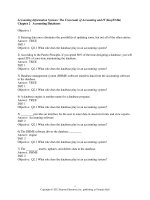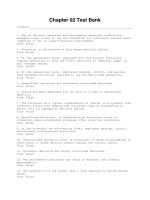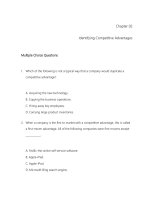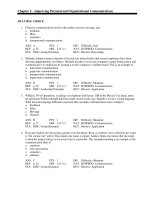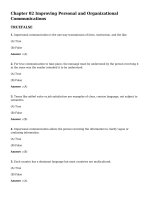Information technology project management providing measurable organizational value 5th edition marchewka test bank
Bạn đang xem bản rút gọn của tài liệu. Xem và tải ngay bản đầy đủ của tài liệu tại đây (369.55 KB, 20 trang )
Information Technology Project Management 5e - Marchewka
Chapter 2: Project Methodologies and Processes
True/False
1. A methodology provides a systematic way to plan, manage, and execute projects.
a. True
b. False
Ans: True
Difficulty: Easy
Ref: INTRODUCTION
2. The Project Management Body of Knowledge (PMBOK®) and PRojects IN
Controlled Environments (PRINCE2®) are two popular and widely used project
management methodologies.
a. True
b. False
Ans: True
Difficulty: Easy
Ref: INTRODUCTION
3. Breaking a project down into phases increases the complexity and project risk.
a. True
b. False
Ans: False
Difficulty: Easy
Ref: THE PROJECT LIFE CYCLE
4. Fast tracking is defined as starting the next phase of a project before the current
phase is complete.
a. True
b. False
Ans: True
Difficulty: Easy
Ref: THE PROJECT LIFE CYCLE
5. PMBOK® views project integration management as one of the most important
because it coordinates the other nine knowledge areas.
c. True
d. False
Ans: True
Difficulty: Easy
1
Information Technology Project Management 5e - Marchewka
Ref: THE PROJECT MANAGEMENT BODY OF KNOWLEDGE
(PMBOK®)
6. The PMBOK® are called project cost management includes estimate costs,
determine budget, and control costs.
a. True
b. False
Ans: True
Difficulty: Easy
Ref: THE PROJECT MANAGEMENT BODY OF KNOWLEDGE
(PMBOK®)
7. A project’s scope is primarily a list of resources available to the project team.
e. True
f. False
Ans: False
Difficulty: Easy
Ref: THE PROJECT MANAGEMENT BODY OF KNOWLEDGE
(PMBOK®)
8. Project management processes include Scope, Schedule, Budget, and Quality.
a. True
b. False
Ans: False
Difficulty: Easy
Ref: PROJECT PROCESSES
9. Contract closure ensures that all of the deliverables and agreed upon terms of the
project have been completed and delivered.
g. True
h. False
Ans: True
Difficulty: Easy
Ref: PROJECT PROCESS
10. PRINCE2® was originally developed for government projects in the United
States.
a. True
b. False
2
Information Technology Project Management 5e - Marchewka
Ans: False
Difficulty: Easy
Ref: PRINCE2®
11. PRINCE2® is similar to the PMBOK® Guide in that it follows the project life
cycle and provides stakeholders with a common language and approach to
managing projects.
a. True
b. False
Ans: True
Difficulty: Easy
Ref: PRINCE2®
12. Under PRINCE2®, any proposed changes to the project that the user wants should
be approved and included.
i. True
j. False
Ans: False
Difficulty: Easy
Ref: PRINCE2®
13.
Under PRINCE2®, the Project Board is accountable for the project’s success
or failure.
a. True
b. False
Ans: True
Difficulty: Easy
Ref: PRINCE2®
14. Although projects follow a project life cycle, the development of new products,
services, or information systems follow a product life cycle.
a. True
b. False
Ans: True
Difficulty: Medium
Ref: THE SYSTEMS DEVELOPMENT LIFE CYCLE (SDLC)
15. The integration of project management and systems development activities is one
important component that distinguishes IT projects form other types of projects
a. True
b. False
3
Information Technology Project Management 5e - Marchewka
Ans: True
Difficulty: Medium
Ref: THE SYSTEMS DEVELOPMENT LIFE CYCLE (SDLC)
16. Waterfall is an iterative development approach while Agile is a structured
development approach.
a. True
b. False
Ans: False
Difficulty: Medium
Ref: THE SYSTEMS DEVELOPMENT LIFE CYCLE (SDLC)
17. The four phases of a learning cycle include: Understand and frame the problem,
plan, act, reflect and learn.
a. True
b. False
Ans: True
Difficulty: Easy
Ref: LEARNING CYCLES AND LESSONS LEARNED
Multiple Choice
1. A project plan includes which of the following:
a)
b)
c)
d)
e)
Project Objectives
Resources
Controls
All of these
None of these
Ans: D
Difficulty: Easy
Ref: THE PROJECT LIFE CYCLE
2. The following are PMBOK® knowledge areas except:
a)
b)
c)
d)
e)
Project Integration Management
Project Scope Management
Project Cost Management
Project Risk Management
Project Research Management
4
Information Technology Project Management 5e - Marchewka
Ans: E
Difficulty: Easy
Ref: THE PROJECT MANAGEMENT BODY OF KNOWLEDGE (PMBOK®)
3. The Project Management Body of Knowledge
a)
b)
c)
d)
e)
is a method of ensuring project success.
must be used on all projects.
is a generally accepted set of principles and practices for project management.
must be used in its entirety.
works the same on all projects.
Ans: C
Difficulty: Easy
Ref: THE PROJECT MANAGEMENT BODY OF KNOWLEDGE (PMBOK®)
4. Project Integration Management
a) focuses on coordinating the project plan’s development, execution, and control
of changes.
b) includes identifying the project phases and activities and estimating,
sequencing, and assigning resources.
c) focuses on planning, developing, and managing the quality environment
allowing the project to meet or exceed stakeholder expectations.
d) focuses on identifying and responding appropriately to risks that can impact
the project.
e) is concerned with acquiring project resources that are outside the organization.
Ans: A
Difficulty: Easy
Ref: THE PROJECT MANAGEMENT BODY OF KNOWLEDGE (PMBOK®)
5. Project Scope Management
a) focuses on coordinating the project plan’s development, execution, and control
of changes.
b) includes identifying the project phases and activities and estimating,
sequencing, and assigning resources.
c) provides assurance that the project's work is defined accurately and completed
as planned.
d) focuses on identifying and responding appropriately to risks that can impact
the project.
e) is concerned with acquiring project resources that are outside the organization.
5
Information Technology Project Management 5e - Marchewka
Ans: C
Difficulty: Easy
Ref: THE PROJECT MANAGEMENT BODY OF KNOWLEDGE (PMBOK®)
6. Project Time Management
a) focuses on coordinating the project plan’s development, execution, and control
of changes.
b) includes identifying the project phases and activities and estimating,
sequencing, and assigning resources.
c) focuses on planning, developing, and managing the quality environment
allowing the project to meet or exceed stakeholder expectations.
d) focuses on identifying and responding appropriately to risks that can impact
the project.
e) is concerned with acquiring project resources that are outside the organization.
Ans: B
Difficulty: Easy
Ref: THE PROJECT MANAGEMENT BODY OF KNOWLEDGE (PMBOK®)
7. The PMBOK® area called project time management includes all of the following
except:
a)
b)
c)
d)
e)
Define Activities
Assign Activities
Estimate Activity Durations
Develop Schedule
Control Schedule
Ans: B
Difficulty: Easy
Ref: THE PROJECT MANAGEMENT BODY OF KNOWLEDGE (PMBOK®)
8. Project Cost Management
a) focuses on coordinating the project plan’s development, execution, and control
of changes.
b) includes identifying the project phases and activities and estimating,
sequencing, and assigning resources.
c) focuses on planning, developing, and managing the quality environment
allowing the project to meet or exceed stakeholder expectations.
d) assures that the project budget is developed and completed as approved.
6
Information Technology Project Management 5e - Marchewka
e) is concerned with acquiring project resources that are outside the organization.
Ans: D
Difficulty: Easy
Ref: THE PROJECT MANAGEMENT BODY OF KNOWLEDGE (PMBOK®)
9. Project Quality Management
a) focuses on coordinating the project plan’s development, execution, and control
of changes.
b) includes identifying the project phases and activities and estimating,
sequencing, and assigning resources.
c) focuses on planning, developing, and managing the quality environment
allowing the project to meet or exceed stakeholder expectations.
d) focuses on identifying and responding appropriately to risks that can impact
the project.
e) is concerned with acquiring project resources that are outside the organization.
Ans: C
Difficulty: Easy
Ref: THE PROJECT MANAGEMENT BODY OF KNOWLEDGE (PMBOK®)
10. Project Human Resource Management
a) focuses on creating and developing the project team.
b) includes identifying the project phases and activities and estimating,
sequencing, and assigning resources.
c) focuses on planning, developing, and managing the quality environment
allowing the project to meet or exceed stakeholder expectations.
d) focuses on identifying and responding appropriately to risks that can impact
the project.
e) is concerned with acquiring project resources that are outside the organization.
Ans: A
Difficulty: Easy
Ref: THE PROJECT MANAGEMENT BODY OF KNOWLEDGE (PMBOK®)
11. Project Communications Management
a) focuses on coordinating the project plan’s development, execution, and control
of changes.
b) includes identifying the project phases and activities and estimating,
sequencing, and assigning resources.
7
Information Technology Project Management 5e - Marchewka
c) focuses on planning, developing, and managing the quality environment
allowing the project to meet or exceed stakeholder expectations.
d) entails providing timely and accurate information about the project to
stakeholders.
e) is concerned with acquiring project resources that are outside the organization.
Ans: D
Difficulty: Easy
Ref: THE PROJECT MANAGEMENT BODY OF KNOWLEDGE (PMBOK®)
12. Project Risk Management
a) focuses on coordinating the project plan’s development, execution, and control
of changes.
b) includes identifying the project phases and activities and estimating,
sequencing, and assigning resources.
c) focuses on planning, developing, and managing the quality environment
allowing the project to meet or exceed stakeholder expectations.
d) focuses on identifying and responding appropriately to risks that can impact
the project.
e) is concerned with acquiring project resources that are outside the organization.
Ans: D
Difficulty: Easy
Ref: THE PROJECT MANAGEMENT BODY OF KNOWLEDGE (PMBOK®)
13. Project Procurement Management
a) focuses on coordinating the project plan’s development, execution, and control
of changes.
b) includes identifying the project phases and activities and estimating,
sequencing, and assigning resources.
c) focuses on planning, developing, and managing the quality environment
allowing the project to meet or exceed stakeholder expectations.
d) focuses on identifying and responding appropriately to risks that can impact
the project.
e) is concerned with acquiring project resources that are outside the organization.
Ans: E
Difficulty: Easy
Ref: THE PROJECT MANAGEMENT BODY OF KNOWLEDGE (PMBOK®)
14. Planning, executing, and monitoring and controlling are examples of:
8
Information Technology Project Management 5e - Marchewka
a)
b)
c)
d)
e)
Project Management process groups.
Project Management tools.
PMBOK® areas of knowledge
Project Management objectives
Project Management infrastructure.
Ans: A
Difficulty: Easy
Ref: PROJECT PROCESSES
15. Initiating processes:
a)
b)
c)
d)
e)
Signal the beginning of the project or phase.
Requires an organization to make a commitment of time and resources.
Are part of the project management processes and ITPM phases.
all of these
none of these
Ans: A
Difficulty: Easy
Ref: PROJECT PROCESSES
16. Planning processes:
a)
b)
c)
d)
e)
Signal the beginning of the project or phase.
Requires an organization to make a commitment of time and resources.
Are part of the project management processes and ITPM phases.
supports planning of the entire project and each individual phase
none of these
Ans: D
Difficulty: Easy
Ref: PROJECT PROCESSES
17. Executing processes:
a)
b)
c)
d)
e)
Signal the beginning of the project or phase.
Requires an organization to make a commitment of time and resources.
focus on integrating people and resources to carry out the planned activities.
supports planning of the entire project and each individual phase
none of these
9
Information Technology Project Management 5e - Marchewka
Ans: C
Difficulty: Easy
Ref: PROJECT PROCESSES
18. Monitoring and controlling processes:
a)
b)
c)
d)
e)
Signal the beginning of the project or phase.
Requires an organization to make a commitment of time and resources.
focus on integrating people and resources to carry out the planned activities.
supports planning of the entire project and each individual phase
allows for managing and measuring progress toward the project’s MOV and
scope, schedule, budget, and quality objectives.
Ans: E
Difficulty: Easy
Ref: PROJECT PROCESSES
19. Closing processes:
a) Signal the beginning of the project or phase.
b) formally accepts the project’s product, service, or end result so the project or
phase can be brought to an orderly close.
c) focus on integrating people and resources to carry out the planned activities.
d) supports planning of the entire project and each individual phase
e) allows for managing and measuring progress toward the project’s MOV and
scope, schedule, budget, and quality objectives.
Ans: B
Difficulty: Easy
Ref: PROJECT PROCESSES
20. Product-oriented processes will define all of the sub-phases and deliverables
associated with the ______ project management life cycle phase.
a)
b)
c)
d)
e)
conceptualize and initialize the project
develop the project charter and plan
execute and control
close project
evaluate project success
Ans: C
Difficulty: Medium
Ref: THE SYSTEMS DEVELOPMENT LIFE CYCLE (SDLC)
10
Information Technology Project Management 5e - Marchewka
21. The following are components of the Agile Manifesto except:
a)
b)
c)
d)
e)
User Involvement over Cost of Project
Individuals and Interactions over Processes and Tools
Working Software over Comprehensive Documentation
Customer Collaboration over Contract Negotiation
Responding to Change over Following a Plan
Ans: A
Difficulty: Medium
Ref: THE SYSTEMS DEVELOPMENT LIFE CYCLE (SDLC)
22. The phases of a learning cycle include all of the following except:
a)
b)
c)
d)
e)
Act
Assess risk
Reflect and learn
Plan
Understand and frame problem
Ans: B
Difficulty: Medium
Ref: LEARNING CYCLES AND LESSONS LEARNED
Short Answer Questions
1.
What are the advantages of having and following a project methodology?
Ans:
A project team can focus on the product or system without having to debate how
the work is to be done.
Stakeholders understand their role, and these roles can be applied to future
projects.
Experiences can be documented in terms of lessons learned and integrated into the
methodology as best practices. Hopefully, previous successes can be repeated.
Past, present, and future projects can be compared with confidence in terms of
planning and progress reporting.
Valuable time can be saved because approaches, tools, techniques, and templates
can be reused across projects.
As you will learn in later chapters, following a methodology provides a useful
template for planning the project work and associated tasks.
Difficulty: Easy
Ref: INTRODUCTION
11
Information Technology Project Management 5e - Marchewka
2.
Describe project integration management and its relationship to the other eight
Project Management Body of Knowledge areas.
Ans: Project integration management is one of the most important Project
Management Body of Knowledge areas. It coordinates and integrates the other
knowledge areas and all of the project processes. Project integration management is
concerned with three areas: (1) project plan development so that a useable, flexible,
and consistent project plan is developed, (2) project plan execution so that the project
plan is carried out in order achieve the project’s MOV, and (3) overall change control
to help manage change so that change does not disrupt the focus of the project team.
Difficulty: Easy
Ref: THE PROJECT MANAGEMENT BODY OF KNOWLEDGE (PMBOK®)
3.
Describe the PMBOK® area of project cost management.
Ans: According to PMBOK, project cost management includes:
Estimate Costs—Based upon the activities, their time estimates, and
resource requirements, an estimate can be developed.
Determine Budget—Once the time and cost of each activity is estimated,
an overall cost estimate for the entire project can be made. Once approved,
this estimate becomes the project budget.
Control Costs—Ensuring that proper processes and procedures are in
place to control changes to the project budget.
Difficulty: Easy
Ref: THE PROJECT MANAGEMENT BODY OF KNOWLEDGE (PMBOK®)
4.
Describe the PMBOK area of project time management.
Ans: The Project Management Body of Knowledge (PMBOK) area called project
time management focuses on the processes necessary to develop the project
schedule and to ensure that the project is completed on time. As defined in the
PMBOK, project time management includes:
Define Activities—identifying what activities must be completed in order to
produce the project scope deliverables.
Sequence Activities—determining whether activities can be completed
sequentially or in parallel and any dependencies that may exist among them.
Estimate Activity Resources – identifying the type of resources (people,
technology, facilities, etc.) and the quantity of resources needed to carry out
project activities.
Estimate Activity Durations—estimating the time to complete each activity.
Develop Schedule —based upon the availability of resources, the activities, their
sequence, and time estimates, a schedule for the entire budget can be developed.
Control Schedule —ensuring that proper processes and procedures are in.
Difficulty: Easy
Ref: THE PROJECT MANAGEMENT BODY OF KNOWLEDGE (PMBOK®)
12
Information Technology Project Management 5e - Marchewka
5.
What is a project’s scope?
Ans: A Project’s scope is the work to be complete by the project team. This may
include specific requirements, features, functionality, or standards for the product or
system to be delivered, or it could include project-related deliverables like the
project’s schedule or budget.
Difficulty: Easy
Ref: THE PROJECT MANAGEMENT BODY OF KNOWLEDGE (PMBOK®)
6.
What is a stakeholder?
Ans: Stakeholders are individuals, groups, or even organizations that have a stake,
or claim, in the project’s outcome.
Difficulty: Easy
Ref: THE PROJECT MANAGEMENT BODY OF KNOWLEDGE (PMBOK®)
7.
List and describe the five common phases or stages shared by most projects?
Ans:
Define Project Goal—All projects have a beginning. Although a project is
initiated when someone comes up with a new idea for perhaps a new product,
service, or system, the first step in beginning a project should be to define the
project’s goal. The project’s goal should make explicit the project’s envisioned
business value because projects are organizational investments that require time
and resources and involve risk. A well-defined goal will set stakeholders’
expectations and drive the other phases of the project. The project goal should
also answer the question: How will we know if this project is successful given the
time, money, and resources invested? Once the project’s goal has been clearly
defined, it must be agreed upon by the project stakeholders before the project can
begin the planning phase.
Plan Project —The project’s goal provides direction for planning the project;
otherwise, it would be like driving a car without a destination in mind. A project
plan defines:
▪ Project Objectives —A project’s objectives include scope (the project work),
schedule, budget, and quality. Objectives support the project’s goal by defining
what work needs to be completed, when it needs to be completed, how much it
will cost to complete, and whether the work is acceptable to specific stakeholders.
▪ Resources —Resources are needed to complete the project work and include
such things as people, facilities, and technology.
▪ Controls —A great deal of managing a project includes ensuring that the project
goal and objectives are being met and resources are used efficiently and
effectively. In addition, risk, change, and communication among the project
stakeholders must be proactively managed throughout the project.
Execute Project Plan —Approval of the project plan is required before moving to
the execution phase. While the plan project phase outlines the anticipated or
13
Information Technology Project Management 5e - Marchewka
planned progress of the project, the execute project plan phase concentrates on
the design, development, and delivery of the project’s product, service, or system.
Moreover, the controls defined in the planning phase now allow the project
stakeholders to compare the project’s planned progress with the actual progress in
terms of the work being completed on time, within budget, and within quality
standards so as to achieve the business value envisioned. At the end of this phase,
the team implements or delivers a completed product, service, or information
system to the organization.
Close and Evaluate Project —A project should have a definite end. The last
phases ensure that all of the work is completed as agreed to by the team, the
sponsor, or other stakeholders. However, the project and the project team should
be evaluated during a postmortem review to determine whether the project’s goal
defined in the initial phase was achieved. In addition, any best practices based on
experiences and lessons learned should be documented and made available to
future projects.
Difficulty: Easy
Ref: THE PROJECT LIFE CYCLE
8.
What are project management processes? Give one example.
Ans:
Project management processes are an integral component of project management and
are concerned with defining and coordinating the activities and controls needed to
manage the project. They support all of the activities necessary to create and
implement the product of the project. Examples include:
Initiating
Planning
Executing
Monitoring and Controlling
Closing
Difficulty: Easy
Ref: PROJECT PROCESSES
9.
Describe the five project management process groups.
Ans:
▪ Initiating—The initiating process group signals the beginning of the project or a
phase. For example, an organization may initiate a project by requiring the
development of a business case as part of its project methodology. During this phase,
a set of project management processes would define how the project and the first
phase of the methodology should be initiated. The approval of the business case
would then provide an authorization to start another set of processes to begin the
second phase of the project methodology. Although all of the phase of the project
should have some type of initiating process, the first phase of the project would be the
most important.
14
Information Technology Project Management 5e - Marchewka
▪ Planning—The planning process group supports planning of the entire project and
each individual phase. Supporting project management processes may include scope
planning, activity planning, resource planning, cost estimating, schedule estimating,
and procurement planning. The planning process should be in line with the size and
complexity of the project—that is, larger, more complex projects may require a
greater planning effort than smaller, less complex projects. Planning processes are
most important during the second phase of the project methodology when planning
the project is emphasized. However, planning processes can be important for each
phase whereby objectives and activities may need to be defined or refined as new
information becomes available. In addition, planning is often an iterative process. A
project manager may develop a project plan, but senior management or the client may
not approve the scope, PMBOK® Project Management Process Groups budget, or
schedule. Or circumstances may arise that warrant changes to the project plan. This
could happen as the result of a competitor’s actions or legislation (external), or even
changes to the project team or sponsor (internal).
▪ Executing —Once a project phase has been approved and planned, the executing
process group focuses on integrating people and resources to carry out the planned
activities of the project plan or phase. During the execute and control phase, the
SDLC and associated project methodology play an important role in developing the
product or system. For example, software engineering processes, tools, and methods
for developing and/or implementing an application system become critical for
delivering the project’s end result. Project management processes such as quality
assurance, risk management, and team development play an important supporting
role. Although executing processes are part of every project phase, the majority of
executing processes will occur during the execute and control phase of the project life
cycle.
▪ Monitoring and Controlling —The monitoring and controlling process group allows
for managing and measuring progress toward the project’s goal and scope, schedule,
budget, and quality objectives. These processes also allow the project manager and
team to keep an eye on project variances between actual and planned results so that
appropriate corrective actions can be taken when necessary. Supporting project
management processes include scope control, change control, schedule control,
budget control, quality control, and a communications plan. The emphasis of
monitoring and controlling processes will occur during the execution and control
phase of the IT project methodology.
▪ Closing —The closing process group provides a set of processes for formally
accepting the project’s product, service, or system so that the project or phase can be
brought to an orderly close. The project manager or team must verify that all project
work has been satisfactorily completed before the project sponsor accepts a phase’s or
the project’s end product. Closure of a project may include processes for contract
closure and administrative closure. Contract closure ensures that all of the
deliverables and agreed upon terms of the project have been completed and delivered
so that the project can end. It allows resources to be reassigned and settlement or
15
Information Technology Project Management 5e - Marchewka
payment of any account. Administrative closure, on the other hand, involves
documenting and archiving all project documents. It also includes processes for
evaluating the project in terms of whether it achieved its goal. Lessons learned should
be documented and made available to other teams. Although each phase must include
closing processes, the major emphasis on closing processes will occur during the
close project and evaluate project success phases of the project methodology.
Difficulty: Easy
Ref: PROJECT PROCESSES
10. What are product-oriented processes? Give one example.
Ans: Product-oriented processes are those which focus on the tangible results of the
project. They require specific domain knowledge, tools, and techniques in order to
complete the work. An example would be the creation of a software application
package.
Difficulty: Easy
Ref: PROJECT PROCESSES
11. What are the three important roles included a Project Board under the
PRINCE2® methodology.
Ans: A customer, a senior user, and a senior supplier.
Difficulty: Easy
Ref: PRINCE2®
12. Describe the seven processes of the PRINCE2® methodology.
Ans:
Start Project—The first process should be relatively short and focused on developing
a project brief or document that provides business justification for the project. The
Project Board is created and determines whether the project should be commissioned
to continue to the next stage. This is more of a basic fact-finding stage, where the
organization attempts to determine whether the project is doable and worth doing
without spending a great deal of time and money.
Initiate Project—The main focus of this process is to develop the project brief into a
more detailed business case, which is a key document that lays a foundation for all
important project decisions. In addition, the project manager documents performance
targets for benefits, costs, schedule, quality, scope, and risk in an overall project plan.
Direct Project—The Project Board’s overall activities are defined so that it can direct
the project successfully throughout each stage up through the project’s closure.
Control Stage—During this process, the project manager’s day-to-day activities are
defined as well as how the project tasks will be controlled and monitored.
16
Information Technology Project Management 5e - Marchewka
Manage Product Delivery—The project manager plans each stage as a set of work
packages to be delivered. A work package includes such things as the products to
delivered, the people authorized to do the work, constraints, tolerances, as well as the
resources and time line for completing the work. This process ensures that the work
packages are developed, delivered, and approved as planned.
Manage Stage Boundaries—This includes the information or reporting mechanisms
the project manager will give to the Project Board in order to review the status of the
project and to determine whether continued business justification for the project
exists.
Close Project—This ensures that the project is completed in a controlled manner if
the project work is completed as planned or if it is no longer viable. More
specifically, activities are defined for the acceptance of the project, as well as for the
project manager to archive documents and release project resources.
Difficulty: Easy
Ref: PRINCE2®
13. Describe the five basic phases in the systems development life cycle.
Ans:
Planning—The planning phase involves identifying and responding to a problem
or opportunity and incorporates the project management and system development
processes and activities. Here a formal planning process ensures that the goal,
scope, budget, schedule, technology, and system development processes,
methods, and tools are in place.
Analysis—The analysis phase attempts to delve into the problem or opportunity
more fully. For example, the project team may document the current system to
develop an “ as is” model to understand the system currently in place. In general,
systems analysts will meet with various stakeholders (users, managers, customers,
etc.) to learn more about the problem or opportunity. This work is done to identify
and document any problems or bottlenecks associated with the current system.
Here the specific needs and requirements for the new system are identified and
documented.
Design—During the design phase, the project team uses the requirements and “ to
be” logical models as input for designing the architecture to support the new
information system. This architecture includes designing the network, hardware
configuration, databases, user interface, and application programs.
Implementation —Implementation includes the development or construction of
the system, testing, and installation. In addition, training, support, and
documentation must be in place.
Maintenance and Support —Although maintenance and support may not be a true
phase of the current project, it is still an important consideration. Once the system
has been implemented, it is said to be in production. Changes to the system, in the
form of maintenance and enhancements, are often requested to fix any discovered
17
Information Technology Project Management 5e - Marchewka
errors (i.e., bugs) within the system, to add any features that were not
incorporated into the original design, or to adjust to a changing business
environment. Support, in terms of a call center or help desk, may also be in place
to help users on an as-needed basis.
Difficulty: Easy
Ref: THE SYSTEMS DEVELOPMENT LIFE CYCLE (SDLC)
14. List and describe the four themes (or categories) of the Agile principles.
Ans:
Customer—Again, Agile takes a strong customer focus, and the customer could
be internal (e.g., the user) or external to the organization. The product or system
must be developed with the customer in mind; therefore, the customer and
developers must communicate and interact effectively in order to work together
collaboratively. The team should be collocated for daily face-to-face
communication.
Product—Only working software brings value, but it must be delivered in the
shortest time practical. Although it is important to give customers what they want,
it is also important to keep things simple and deliver only the most important
features or functionality. Change is not the enemy. It is an opportunity.
Project Team—An Agile team should include business people and technical
people who are motivated, self-organizing, and mutually accountable. A team
should be given the support and resources it needs and then trusted to get the job
done. People who work long hours may burn out, get tired, become less
motivated, and tend to make more mistakes. Therefore, the team should be able to
work at a pace that is constant and sustainable.
Performance—The team should have the authority to make adjustments when
needed. In addition, a product is complete only when it is designed, tested,
documented, and working.
Difficulty: Easy
Ref: THE SYSTEMS DEVELOPMENT LIFE CYCLE (SDLC)
15. Describe the three important roles under Scrum, one of the Agile methods.
Ans: Scrum master, product owner, and the development team. The Scrum master is
similar to the project manager, while the product owner represents the business side
and ensures that the most important features are included in the product. The
development team is responsible for delivering a quality product or system.
Difficulty: Medium
Ref: THE SYSTEMS DEVELOPMENT LIFE CYCLE (SDLC)
16. John Redding suggests that a team learning cycle has four phases. What are
they?
Ans: Understand and frame the problem, Plan, Act, Reflect and learn, Breadth
Difficulty: Easy
18
Information Technology Project Management 5e - Marchewka
Ref: LEARNING CYCLES AND LESSONS LEARNED
17. Describe the concept of a learning cycle.
Ans: Learning cycles provide a way to resolve ambiguous situations through the
repeated pattern of thinking through a problem. A learning cycle has four phases:
Understand and frame the problem
Plan
Act
Reflect and learn
Difficulty: Easy
Ref: LEARNING CYCLES AND LESSONS LEARNED
18. What purpose does creating a lessons learned at the end of a learning cycle
provide?
Ans: The completion of a team’s lessons learned marks the ending of one learning
cycle and the beginning of another. Based on the learning that has transpired, the
team can focus once again on understanding and reframing the problem and then
repeat the plan, act, reflect and learn phases again.
Difficulty: Easy
Ref: LEARNING CYCLES AND LESSONS LEARNED
19
Information Technology Project Management 5e - Marchewka
Essay Questions
1. What is a project methodology?
2. Describe the phases of the project life cycle.
3. List the five Project Management Process Groups and describe how they support
the phases of the project life cycle.
4. The Guide to Project Management Body of Knowledge defines ten knowledge
areas for understanding project management. Name and briefly describe five of
them.
5. The Guide to Project Management Body of Knowledge defines a process as “a set
of interrelated actions and activities performed to achieve a pre-specified product,
result, or service”. In your own words, state what this definition means and give
an example.
6. How should proposed changes in the project be handled and what are the relevant
criteria for change decisions?
7. What are the seven principles that must be followed in order to be considered a
PRINCE2® project?
8. How do the project life cycle (PLC) and the systems development life cycle
(SDLC) differ?
9. Describe the phases of a learning cycle and discuss the potential impact of its use
on organizations.
20


